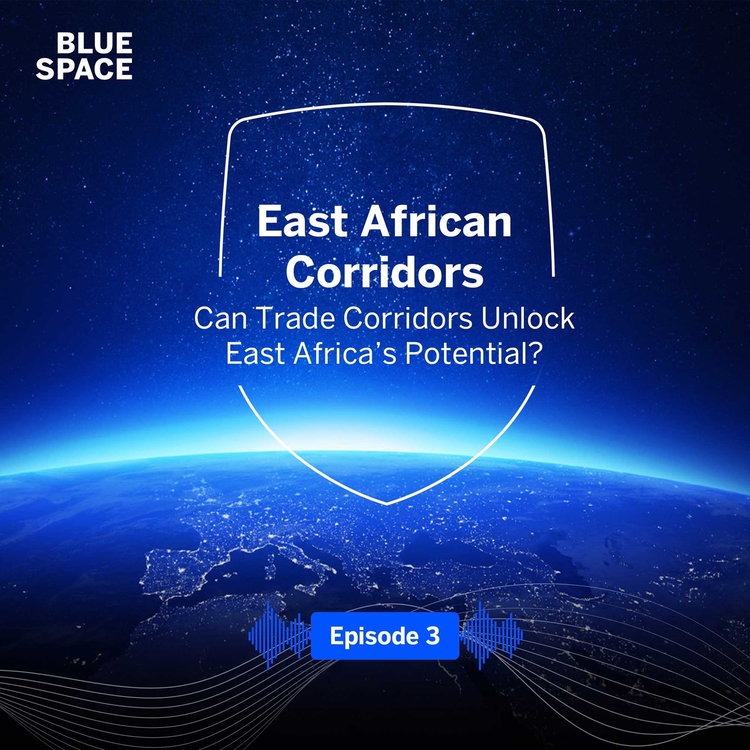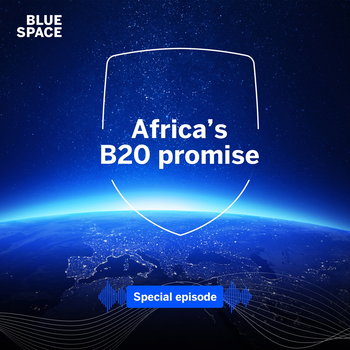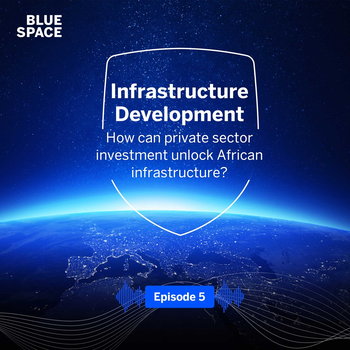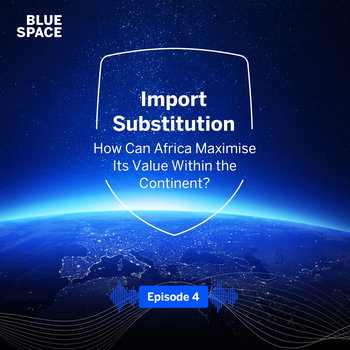00:03:
Hi, I'm Joanne Joseph and welcome to the latest episode of The Blue Space.
00:08:
We're coming to you from the Kenyan capital, Nairobi, and we find ourselves
00:14:
perched this morning on one of the tallest buildings in the country.
00:16:
The East Africa Corridor covers eight countries.
00:18:
It will soon be home to half a billion people sitting on some of the richest
00:24:
natural resources on the continent.
00:26:
While the rest of Africa is trying desperately to unlock growth, the East
00:30:
Africa Corridor is powering ahead.
00:32:
What does its success mean for the rest of the continent?
00:34:
Let's find out in the Blue Space.
00:45:
My name is Kitrono Kitong and I'm a businessman and I'm also the chairman of
00:50:
the Nairobi Securities Exchange.
00:52:
My name is Patrick Moahire.
00:53:
I'm the regional CEO for Standard Bank across East Africa, covering six
00:58:
countries.
01:04:
What is current on my playlist in my car is Hugh Masekela.
01:07:
It's Otis Redding.
01:09:
It is Sam Cooke.
01:11:
Oh, I've got some Afro beats.
01:14:
I've got some jazz.
01:16:
I'm a piano.
01:17:
I love the Senegalese and Mali music.
01:20:
What do you think of when you think of Africa?
01:23:
I think of a very vast and diverse continent.
01:28:
with a very young demographic.
01:30:
It's got the history, it's got the landscape, it's got somewhat going for it.
01:35:
And I think it's also quite cosmopolitan and quite eclectic.
01:42:
Welcome back to The Blue Space, brought to you by Standard Bank Corporate and
01:46:
Investment Banking.
01:48:
I'm Joanne Joseph, and today I'm joined in Nairobi by Standard Bank's Regional Chief
01:53:
Executive for East Africa.
01:55:
Patrick Mohire and Chairman of the Nairobi Securities Exchange, Kiprona Kitoni.
01:58:
Gentlemen, lovely to be with you today and thank you very much for making the time to
02:02:
chat.
02:02:
So Patrick, let me kick off with you.
02:04:
I'd like you to please just give us a sense of East Africa as a region.
02:08:
What corridors exist here?
02:10:
Tell me how they enable trade, the movement of people, labour, currency and
02:15:
the like.
02:15:
Okay, I'm happy to.
02:17:
First of all, I think it's important to put this in context.
02:21:
The East African community started, you know, almost 55 years ago.
02:26:
So we've been at this for a while.
02:28:
There was a small disruption in the 70s, but then we continually picked up from it
02:33:
again.
02:35:
So what you find is that there's a lot of connectivity and a lot of trade amongst
02:41:
all the three countries.
02:43:
Just to give you one perfect example, Kenya is the largest export market for
02:47:
Uganda.
02:48:
Uganda is the largest export market for Kenya.
02:51:
We don't see that kind of connectivity.
02:54:
And then there's been a lot of sort of kind of understanding and collaboration
03:00:
all the way from the leaders,
03:02:
the presidents, the technocrats, the finance people,
03:05:
to sort of harmonize and make sure that the rules and all the unifying factors
03:11:
that make us
03:13:
successful continue to be.
03:14:
And there are many, many unifying factors.
03:16:
English and Swahili is a common language.
03:19:
We have a lot unknown.
03:21:
In terms of legislation that depends on each other and there's continuous work in
03:28:
the background to make sure that we harmonize
03:30:
all the policies and that we allow to remove barriers.
03:32:
We have one stop borders at that moment where goods and services can cross
03:39:
very, very easily on the border.
03:42:
And I just think that it's a fantastic job of collaboration.
03:47:
I find that quite incredible, Patrick.
03:48:
I mean, I'm a member of SADC, as you probably know, Kiprono.
03:52:
We just haven't reached that point yet,
03:54:
but we certainly look to the East Africa corridor as a kind of signifier of hope
04:01:
for how
04:03:
we can start to cooperate in the future.
04:05:
I have had the unique opportunity of being close to, I mean,
04:08:
witnessing a lot of the developments in the integration of the East African region
04:14:
from a corporate, from an economic standpoint,
04:16:
from a political standpoint.
04:18:
And also from a social standpoint, because in my previous capacity as the President
04:23:
of the Chamber of Commerce in Kenya, in my current role,
04:25:
we have been actively involved in the leadership space on private sector.
04:26:
And like Patrick says, I mean, there has been a lot of work that's gone into it.
04:30:
And of course, you know, we learned a lot from the pitfalls of the
04:34:
1970s. Our leaders have sat down to try to make this region work.
04:39:
And I think it is work in progress, and I'm sure and I am convinced beyond a
04:43:
shadow of doubt.
04:45:
That we are at the cusp of a great renaissance.
04:47:
If we look at the competitive and the comparative advantages that each of the
04:53:
countries in the East African region present to each other,
04:55:
there is always something to be attributed to what each country can bring to the
04:59:
table.
05:00:
I'll give you an example.
05:01:
In the year 2000, the trade between Kenya and Uganda was 19 to 1 in favor of Kenya.
05:08:
In 2019, Uganda had a trade surplus over Kenya.
05:12:
And Kenya has the port, access to the port, and Uganda is a landlocked country.
05:18:
So if you look at that, it's a clear manifestation of the dynamism of our
05:23:
economies.
05:25:
And I think there has also been a lot of effort in dealing with the non-tariff
05:29:
barriers.
05:31:
One of the greatest sticky points in the cooperation between these nations has been
05:37:
the movement of goods at the border points.
05:39:
And this was resolved by a very simple, you know, treaty that was, you know,
05:43:
engaging by the countries of the East African region to have a one-stop border
05:48:
post.
05:48:
So today, if I'm going to cross into Tanzania for argument's sake at the port
05:53:
of Namanga,
05:55:
I don't need to go through two different buildings.
05:56:
Right.
05:57:
The customs officials are in one.
05:59:
one facility as are the immigration officials.
06:01:
So there's a lot of small things that have gone towards actually making this a
06:06:
reality.
06:06:
It's really exciting stuff.
06:08:
I mean Kiprona, can you give us a sense of how these transit and trade corridors are
06:13:
unlocking
06:14:
value for business as well as the local communities because I think the
06:21:
combination of those two is quite
06:23:
important.
06:25:
Thank you.
06:27:
That's really a very important question that you've asked me.
06:29:
And a few years ago, Trademark East Africa financed an initiative to try and simplify
06:31:
cross-border trade in the East African region.
06:33:
And it began, first of all, with a protocol at the port of Mombasa that will
06:39:
reduce the amount of time that
06:41:
vessels will be docked in Mombasa.
06:43:
It also reduces the amount of time that containers going into the hinterland, into
06:48:
the landlocked countries and also into Kenya itself,
06:50:
would be stationed in Mombasa.
06:51:
So it really worked.
06:52:
on the flow of the goods.
06:55:
And the second thing that has been done is that the Northern Corridor Initiative,
06:58:
which combines all the six countries of the East African region,
07:03:
meet regularly under the auspices of the heads of state with a council of ministers
07:08:
sitting beneath them.
07:10:
And their responsibility is basically to ensure that we have robust infrastructure
07:15:
deployed
07:17:
and also maintained.
07:19:
You see, the deploying of infrastructure and the maintenance of infrastructure are
07:21:
two different conversations.
07:23:
So there is a harmonization of policy in terms of ensuring that our road networks
07:27:
are efficient,
07:29:
our internet connectivity across the region from the undersea connectivity in
07:34:
Mombasa and Dar es Salaam are
07:36:
deployed into the region effectively,
07:38:
that we have enough airports and rail connectivity through standard gauge rail
07:43:
across the region.
07:45:
Mombasa has been a pivotal point because that is a deep water port that serves
07:49:
Kenya.
07:49:
As Dar es Salaam serves Burundi and also parts of Uganda and the Democratic
07:55:
Republic of Congo.
07:57:
So we have, all these countries are working concertedly to ensure that this
08:01:
infrastructure is robust enough to support trade and investment.
08:04:
The human resource protocols have also worked to ensure that there is a seamless
08:10:
flow of people across these regions.
08:12:
Today, I can fly to Dar es Salaam as I will.
08:14:
in a few days' time using my national identity card.
08:17:
No need for a passport.
08:19:
Similarly to Uganda and the rest of the region.
08:21:
That also helps in a great way.
08:24:
The other thing that I want to highlight is the fact that there is a dedicated deep
08:31:
water port in Lamu for the
08:33:
region.
08:35:
And that is even targeting to transport cargo northwards into Ethiopia.
08:37:
But I see that before we leave this issue of the cross-border cooperation, Tell me a
08:44:
little bit about this borderless banking, please, Patrick.
08:46:
I see it's also being used to facilitate the movement of currencies quite easily
08:49:
across borders.
08:51:
Yeah.
08:53:
So, I mean, effectively, what we've tried to do is to make sure that we reduce the
08:57:
time that we can send
08:59:
money across the countries.
09:01:
And that's a big, big benefit to a lot of the trade that happens.
09:04:
So you can seamlessly, within less than 10 minutes, get money across from Kenya to
09:10:
Tanzania.
09:12:
and vice versa.
09:14:
And obviously our clients love that.
09:15:
The ability that also from a macro perspective,
09:20:
there is a little bit of harmonization in terms of interest rates, etc.
09:24:
The central banks all coordinate.
09:27:
We have an East African payment system as well that we're trying to push through.
09:32:
In fact, there is a goal to get us back to a monetary union where we go back to one
09:37:
currency across East Africa.
09:40:
So that's a discussion.
09:41:
We've gotten a lot on the harmonization of rates and policy and targets,
09:46:
but we still have that aspiration that we can go back to one currency across all
09:52:
these countries.
09:54:
And as you know, that would be significant because it reduces a lot of volatility and
09:58:
it allows
09:58:
for even a freer moving.
10:00:
of exchange goods and services.
10:04:
And I think it's something a lot of the countries on the continent are actually
10:09:
aspiring to right now, Patrick.
10:11:
It seems like such a vibrant context in which to operate.
10:14:
I mean, you've got all these facilities,
10:17:
all these pipelines in place to facilitate such a lot of movement,
10:24:
create such opportunities.
10:26:
within this environment.
10:27:
I mean you can afford to truly be creative with the kind of infrastructure that
10:32:
you've put in place.
10:34:
Can you give me a sense of Standard Bank's activities within the region?
10:37:
Yeah, so obviously we, being one of the largest banks in Africa,
10:43:
have to support and really in many ways align with the goals of the countries.
10:50:
So when you look at some of the big infrastructure projects that Kip talked
10:54:
about.
10:55:
We try to play a role in those capital in supporting that so energy and
11:01:
infrastructure is huge
11:03:
both both renewable
11:05:
and extractives we also support a lot of the big should i say fintech space that's
11:10:
been created and
11:11:
you know kenya like very very innovative with the mpesa product which to some
11:18:
extent has also been a
11:20:
competitor in sort of our banking services but it has allowed all of us to to sort of
11:24:
move up.
11:26:
The digitization chain a lot quicker.
11:28:
So money can flow and payments can flow within the countries quite quicker than in
11:34:
any other places.
11:36:
So we also play a huge role in sort of supporting the SME ecosystem.
11:39:
And one of the things that we've been doing lately, which has been very quite
11:46:
successful, is that we see an anchor client,
11:48:
for example, if I was to pick East African breweries, just as an example, and we sit
11:53:
down with them and have a discussion around
11:55:
Their ecosystem.
11:57:
Who supplies you?
11:59:
Who delivers and distributes for you?
12:01:
And can we sit down and then figure out a way in which that we work together?
12:05:
Because one of the biggest issues that we've faced has been the high cost of,
12:10:
should I say,
12:12:
borrowing for SMEs.
12:14:
So we've been working very closely with these large anchor clients to see how do
12:21:
we de-risk so we can lower the rates.
12:23:
And for example, in East African breweries case,
12:25:
we were able to reduce what we were charging the SMEs by almost 40%
12:31:
because we had them on the table.
12:33:
So we had a tripartite and we were able to discuss that this is your ecosystem.
12:37:
If you want us to support this, we're going to do that.
12:40:
So, you know, give us that.
12:42:
So we are also trying to bring all those linkages across for our big anchor
12:48:
corporate clients.
12:50:
And it's working really,
12:52:
really well in terms of just allowing us to also be a banker for the SMEs in that
12:56:
space.
12:57:
If I may, let me give a customer's perspective.
13:02:
And I'm not here to do any marketing for Standard Bank.
13:07:
But I was present when they came into the country maybe 20 plus years ago.
13:12:
And at that time, the image that Standard Bank had was to do the corporate bank, to
13:17:
bank the big corporates.
13:19:
But, you know, to the spirit of East Africa, they have really taken up the
13:23:
innovative spirit.
13:25:
And there are three spaces that I would say Standard Bank has significantly, you
13:28:
know, participated in.
13:30:
One is in agriculture.
13:32:
I mean, Standard Bank today is one of the foremost banks in providing solutions to,
13:34:
you know,
13:36:
the rapidly growing agri-economy space.
13:39:
Number two is in the technology space.
13:40:
As Patrick just said, just now, they have been very actively involved also.
13:43:
but also in banking, the innovative companies that are playing in that space.
13:49:
And thirdly, of course, is the SMEs.
13:51:
I mean, you know that digitization is really on the upswing, and I think they
13:57:
have been one of the banks that have really been at the
13:59:
forefront in ensuring that there is seamless trade flows between the small and
14:03:
medium-sized enterprises, not just in.
14:05:
country, but even cross-border.
14:07:
That's really heartening.
14:09:
Of course, everything we're talking about is what the African Free Trade Agreement
14:12:
is trying to achieve, right?
14:14:
We hear a lot about the AFCFTA.
14:16:
And Patrick, quite frankly, some people believe it to be a pipe dream.
14:20:
Others say it is possible to achieve in a number of years, over a certain number of
14:25:
decades.
14:25:
I mean, it's taken about 50 years for your region to be able to operate as optimally
14:31:
as it does.
14:33:
Would you say this can be achieved in our lifetime continentally?
14:36:
I think, first of all, it was an incredibly ambitious project to do the
14:41:
AFTC.
14:43:
So the way I kind of look at it is that we have to take it in bite size, right?
14:48:
I think trying to ensure that you can have this one huge program,
14:55:
just initially, you know, it's going to take a bit of time.
14:59:
And we have stepped up.
15:00:
We're starting to see some small wins where countries are beginning to have
15:06:
these bilateral trade agreements.
15:08:
For example, there's one really good example I have.
15:12:
We have a lot of excess milk in Uganda. We recently signed a deal with
15:17:
Algeria to export that excess milk.
15:21:
Now, that's also part of the AFTC framework.
15:25:
But how do we continue to have those sort of small wins?
15:29:
Without necessarily just thinking there's going to be a big explosion and a big end
15:33:
to the AFTC.
15:35:
So that's kind of how I look at it.
15:37:
And I feel like we're making progress.
15:40:
At least there's some real conversations that are happening between leaders in
15:46:
terms of how to get this going.
15:48:
But it will take time.
15:49:
But I think the East African community, East African corridors,
15:55:
the entire East African region serves as a model.
15:57:
to the rest of the continent.
15:59:
Kiprona, I mean, surely they can take a leaf out of your book.
16:02:
I had a unique opportunity of being able to travel to many countries in my previous
16:07:
capacity in the Chamber of Commerce.
16:09:
And one of the things that really surprised me is the fact that we haven't,
16:14:
Africa has not traded with Africa.
16:16:
If you travel to West Africa, for example, and you visit a supermarket in Nigeria,
16:21:
you will find that
16:23:
Nigerian supermarkets are mainly stocking dairy products from New Zealand and
16:26:
Australia.
16:27:
And in Kenya, we have a surplus of those same, very, very same products.
16:31:
So there is a need to have a concerted effort to break down the barriers to
16:35:
trade.
16:36:
When we tried to sign a special status agreement between our two countries, we
16:40:
met...
16:41:
Headwinds because of the ECOWAS region having to approve certain,
16:45:
or rather take away certain barriers to being able to enable us to travel.
16:49:
I mean take our goods there and vice versa also to import petroleum products directly
16:55:
through that special status agreement into Kenya.
16:57:
So there are real practical examples of the challenges that the historical
17:02:
formations have presented.
17:04:
One very clear example also has been the sea routes.
17:06:
You know it's easier today to...
17:08:
Transport a container from the port of Mombasa to Felix to the United Kingdom,
17:13:
then it is to transport it to the port of Lagos.
17:16:
Because of the sea routes and the fact that there haven't been enough vessels
17:20:
plying those routes.
17:22:
And many of these vessels actually have detoured to other transit points,
17:26:
the global sea configuration.
17:28:
So there are certain low-hanging fruits.
17:31:
If you look at the collaboration today, for example, in the utility of energy
17:36:
resources,
17:38:
It's a perfect example of how East Africa is leading from the front.
17:40:
Ethiopia, with its Grand Renaissance Dam, will be exporting their surplus energy
17:47:
into Kenya.
17:49:
We import hydropower resource from Uganda.
17:52:
We shall be exporting our geothermal resources to other neighboring countries.
17:56:
So there is a close collaboration that is premised upon the competitive and the
18:03:
comparative advantages that each of
18:05:
these countries has.
18:07:
It's a long way coming, but I do believe that the journey has began.
18:08:
And to quote and paraphrase Chinua Achebe, he said that if you want to walk fast,
18:13:
walk alone.
18:15:
But if you want to walk far, walk with others.
18:15:
So I think in this region we are walking together.
18:18:
And it's a perfect example for the rest of the continent.
18:20:
It certainly is.
18:21:
I can't disagree with you at all there, Kebrono.
18:24:
Patrick, a closing thought from you.
18:26:
East Africa's growth points as you move forward, because it seems there's lots of
18:32:
room for expansion, despite what you've already achieved.
18:34:
Yeah.
18:36:
So, I mean, we are the fastest growing region in sub-Saharan Africa.
18:39:
I believe we're going to achieve about 6.5% growth for the next couple of years,
18:44:
which is significantly larger than the rest of the continent.
18:49:
And that's without some of the benefits of the big projects that are in the pipeline,
18:56:
you know, technically
18:58:
Tanzania, etc.
19:00:
The FDI that we're beginning to see, which is...
19:03:
In my view, I think, basically shows you the positive sentiment that people see.
19:09:
Not just the bank.
19:11:
We're investing a lot in East Africa.
19:13:
We feel like it's one of our growth vectors from a geographic point of view.
19:17:
It's one of the top three that we've selected as a bank.
19:20:
But when we speak to our clients, it's a similar discussion.
19:23:
You know, like you opened up by saying almost 500 million people, GDP of about
19:30:
500 billion.
19:32:
I'm growing at six, seven percent with a lot of connectivity.
19:37:
It makes it so much easier for a regional corporate or an international,
19:42:
multinational to have that discussion.
19:45:
So I'm very, very optimistic about the future.
19:48:
We will continue to play our role in connectivity.
19:51:
We do have international presence in London and New York, etc.
19:56:
to support international clients as well that want to invest in East Africa.
20:01:
So I feel like we will continue to be a very good cog in the wheel in sort of
20:08:
driving this sort of growth as we move
20:10:
forward and therefore enhance the growth rates that we're already beginning to see.
20:14:
Well, you certainly are a beacon for the rest of us in this region and certainly
20:19:
for regions all over the world.
20:21:
I thank you so much for making the time to speak to us today, gentlemen.
20:23:
We have to wrap it up there today.
20:25:
That is unfortunately all we have time for.
20:27:
But what a fascinating discussion with these two gentlemen.
20:30:
East Africa Regional Chief Executive for Standard Bank, Patrick Mujire, and
20:37:
Chairman of the Nairobi Securities Exchange,
20:39:
Kiprone Kitoni.
20:41:
Thank you both for joining us for this really insightful discussion.
20:41:
From me, Joanne Joseph, to all of you across Africa and around the world,
20:45:
it's goodbye until we meet again here in the Blue Space.
20:50:
Visit www.standardbank.com forward slash bluespace to find out more about the blue
20:56:
space.






